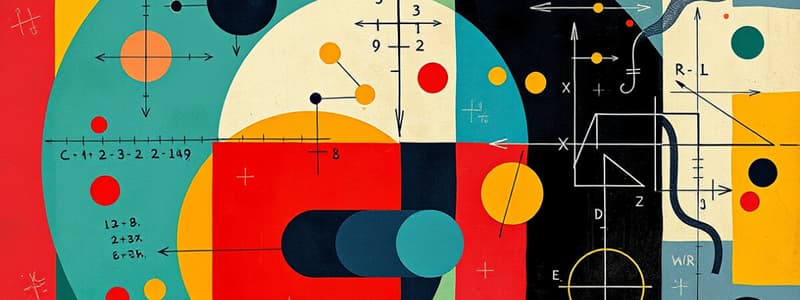Podcast
Questions and Answers
Match the branches of mathematics with their primary focus:
Match the branches of mathematics with their primary focus:
Arithmetic = Basic operations like addition and subtraction Algebra = Manipulating symbols and equations Geometry = Shapes and properties of space Statistics = Data collection and analysis
Match the following terms with their meanings:
Match the following terms with their meanings:
Variable = A symbol representing an unknown quantity Function = A relationship assigning exactly one output for each input Equation = A mathematical statement indicating equality Inequality = A representation of relationships between quantities that are not equal
Match the mathematical branches with their applications:
Match the mathematical branches with their applications:
Calculus = Examines change and motion Trigonometry = Studies relationships in triangles Discrete Mathematics = Focuses on structures that are not continuous Statistics = Analyzes data and makes interpretations
Match the following concepts with their descriptions:
Match the following concepts with their descriptions:
Match the following branches of mathematics with key topics:
Match the following branches of mathematics with key topics:
Match the branches of mathematics with their fundamental concepts:
Match the branches of mathematics with their fundamental concepts:
Match the following terms with their respective branches:
Match the following terms with their respective branches:
Match the applications of mathematics with their fields:
Match the applications of mathematics with their fields:
Match the following mathematical operations with their categories:
Match the following mathematical operations with their categories:
Flashcards are hidden until you start studying
Study Notes
Overview of Mathematics
- Mathematics is the study of numbers, quantities, shapes, and patterns.
- It is divided into various branches, each with its own focus and applications.
Major Branches of Mathematics
-
Arithmetic
- Deals with basic operations: addition, subtraction, multiplication, division.
- Fundamental for all mathematical concepts.
-
Algebra
- Involves symbols and rules for manipulating those symbols.
- Key concepts include variables, equations, functions, and polynomials.
-
Geometry
- Focuses on shapes, sizes, and the properties of space.
- Major topics: points, lines, angles, surfaces, and solids.
-
Trigonometry
- Studies relationships between angles and sides of triangles.
- Key functions: sine, cosine, tangent.
-
Calculus
- Examines change and motion through derivatives and integrals.
- Two main branches: differential calculus (rates of change) and integral calculus (accumulation of quantities).
-
Statistics
- Involves the collection, analysis, interpretation, and presentation of data.
- Key concepts include mean, median, mode, standard deviation, and probability.
-
Discrete Mathematics
- Studies mathematical structures that are fundamentally discrete rather than continuous.
- Topics include graph theory, combinatorics, and logic.
Key Concepts
- Numbers: Types include natural numbers, integers, rational numbers, and real numbers.
- Equations and Inequalities: Represent relationships between quantities.
- Functions: A relationship that assigns each input exactly one output; types include linear, quadratic, polynomial, and exponential.
- Mathematical Proofs: Logical arguments demonstrating the truth of a statement.
Applications of Mathematics
- Science: Used for modeling and solving scientific problems.
- Engineering: Critical for design, analysis, and system optimization.
- Economics: Helps in analyzing trends and making decisions based on data.
- Technology: Underpins algorithms, programming, and data structures.
Problem-Solving Strategies
- Understand the Problem: Read carefully and identify what is being asked.
- Devise a Plan: Determine the steps or formulas needed to solve it.
- Carry Out the Plan: Execute the steps methodically.
- Review/Check: Verify the solution for accuracy and reasonableness.
Mathematical Notation
- Uses symbols and abbreviations to represent numbers and operations.
- Common symbols include + (addition), - (subtraction), × (multiplication), ÷ (division), = (equals), and ≈ (approximately equal).
Importance of Mathematics
- Develops critical thinking and problem-solving skills.
- Essential for various fields and professions.
- Enhances logical reasoning and analytical abilities.
Overview of Mathematics
- Mathematics encompasses the study of numbers, quantities, shapes, and patterns.
- It consists of various branches, each specializing in different aspects and applications.
Major Branches of Mathematics
-
Arithmetic
- Fundamental operations: addition, subtraction, multiplication, division.
- Essential for understanding all mathematical concepts.
-
Algebra
- Utilizes symbols and specific rules to manipulate these symbols.
- Key elements include variables, equations, functions, and polynomials.
-
Geometry
- Investigates shapes, sizes, and the properties of space.
- Covers fundamental topics such as points, lines, angles, surfaces, and solids.
-
Trigonometry
- Focuses on the relationships between angles and sides of triangles.
- Fundamental functions include sine, cosine, and tangent.
-
Calculus
- Studies change and motion, utilizing derivatives and integrals.
- Two main components are differential calculus (examining rates of change) and integral calculus (focusing on accumulation of quantities).
-
Statistics
- Involves the collection, analysis, interpretation, and presentation of data.
- Important concepts include mean, median, mode, standard deviation, and probability.
-
Discrete Mathematics
- Investigates discrete mathematical structures instead of continuous ones.
- Key areas encompass graph theory, combinatorics, and logical reasoning.
Key Concepts
-
Numbers
- Categories include natural numbers, integers, rational numbers, and real numbers.
-
Equations and Inequalities
- Serve to represent relationships between various quantities.
-
Functions
- Define a relationship where each input correlates to a single output; examples include linear, quadratic, polynomial, and exponential functions.
-
Mathematical Proofs
- Logical arguments crafted to demonstrate the validity of mathematical statements.
Applications of Mathematics
-
Science
- Vital for model building and solving complex scientific issues.
-
Engineering
- Crucial in design, analysis, and optimizing systems.
-
Economics
- Aids in evaluating trends and making informed decisions based on data.
-
Technology
- Forms the basis for algorithms, programming languages, and data structures.
Problem-Solving Strategies
-
Understand the Problem
- Thoroughly read and discern the problem's requirements.
-
Devise a Plan
- Outline necessary steps or formulas for resolution.
-
Carry Out the Plan
- Systematically implement the devised steps.
-
Review/Check
- Confirm the solution's accuracy and logical consistency.
Mathematical Notation
- Employs symbols and abbreviations to signify numbers and operations.
- Common symbols include:
-
- for addition
-
- for subtraction
- × for multiplication
- ÷ for division
- = for equality
- ≈ for approximation.
-
Importance of Mathematics
- Cultivates critical thinking and enhances problem-solving abilities.
- Integral for numerous fields and professional practices.
- Develops logical reasoning and analytical skills vital for decision-making.
Studying That Suits You
Use AI to generate personalized quizzes and flashcards to suit your learning preferences.




